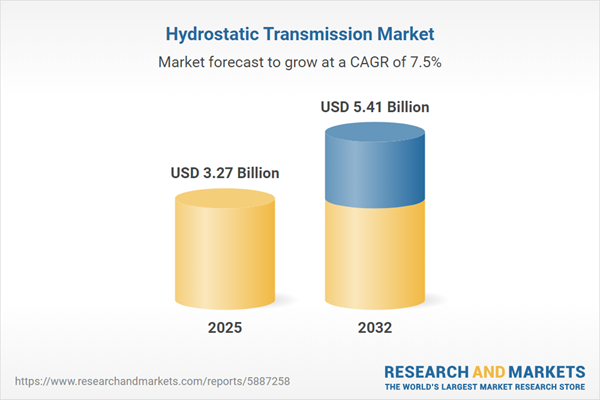Speak directly to the analyst to clarify any post sales queries you may have.
As automation and digitalization drive transformation across industrial sectors, the hydrostatic transmission market stands at the intersection of reliability, operational flexibility, and safety. Senior leaders seeking to optimize system uptime and adapt to evolving demands are recognizing the strategic role of hydrostatic transmission solutions in future-proofing operations.
Market Snapshot: Hydrostatic Transmission Market Size and Growth Trends
The hydrostatic transmission market is exhibiting strong growth as adoption of digital and automated systems accelerates across industrial environments. With the market valued at USD 3.04 billion in 2024, projections indicate an increase to USD 3.27 billion by 2025 and a further rise to USD 5.41 billion by 2032, supported by a compound annual growth rate of 7.45%.
This positive trend highlights a growing focus on integrating mechanical, electrical, and control system technologies. Investments in automation-ready platforms are reshaping operational efficiency for both stationary and mobile applications, and companies are emphasizing system innovation, regulatory compliance, and risk management in their strategic planning.Scope & Segmentation: Drivers and Opportunities
- Application Segments: Hydrostatic transmission systems are utilized widely in agricultural machinery, improving resource management and optimizing movement. They are integral to construction equipment, material handling, mining, and marine environments, where precise control and safety are critical for demanding field operations.
- System Types: Closed loop configurations cater to use cases requiring frequent adjustments in speed and load, benefiting organizations with dynamic operational needs. Open loop systems contribute to consistent throughput and are suitable for both industrial and specialized niches emphasizing process scalability.
- Power Rating Categories: High-power hydrostatic transmission systems are deployed for sustained, heavy-duty workloads. Medium-power solutions meet a broad array of stationary and mobile requirements, while low-power units maintain operational integrity in purpose-specific equipment.
- End Use Industries: Key sectors adopting these systems include agriculture, oil and gas, manufacturing, mining, and construction. Hydrostatic solutions drive process automation, equipment reliability, and facilitate compliance with evolving regulatory and safety standards.
- Regional Coverage: Regional dynamics reflect compliance mandates, policy incentives, and differing workforce expertise levels. Unique market behaviors across the Americas, Europe, Middle East, Africa, and Asia-Pacific are shaped by technological uptake and localized deployment approaches.
- Leading Companies: Industry leaders such as Bosch Rexroth AG, Parker-Hannifin Corporation, Danfoss A/S, Eaton Corporation plc, Kawasaki Heavy Industries, Moog Inc., Linde Hydraulics, Yuken Kogyo, Nachi-Fujikoshi, and HydraForce Inc. are advancing adaptable systems, providing tailored solutions, and fulfilling complex, cross-border project requirements.
Key Takeaways: Strategic Insights for Market Leaders
- Integrating smart sensors and digital control systems enables real-time condition monitoring and predictive maintenance, enhancing equipment reliability and reducing unexpected downtime.
- Modular hydrostatic design provides flexibility, allowing organizations to scale or reconfigure operations efficiently in response to shifting requirements, supporting business continuity.
- Coordinated collaboration between engineering, procurement, and supply chain teams expedites technology implementation and supports agile decision-making across organizational levels.
- Diversifying sourcing and expanding regional manufacturing reinforce supply chain stability, helping to minimize the impact of global disruptions and maintain steady operations.
- The use of digital platforms and additive manufacturing eases customization and delivery of hydrostatic solutions tailored to the precise needs of industrial clients.
- Strategic procurement of mission-critical system components supports effective cost management and ensures stability of supply in volatile market conditions.
Tariff Impact: Managing Production Costs and Supply Chain Risks
Evolving tariff regulations within the United States are prompting hydrostatic transmission manufacturers to increase domestic production and reassess sourcing models. Companies focused on strengthening local supplier relationships and initiating international partnerships are responding with adaptive strategies to maintain operational reliability during changes in international trade policy.
Methodology & Data Sources
This report combines technical documentation analysis, industry publications, and regulatory data with insights gathered from executive interviews and carefully structured industry surveys. These methods ensure that current trends in the hydrostatic transmission market are validated and guidance remains actionable for decision-makers.
Why This Report Matters
- Enables executive teams to make informed investments in hydrostatic transmission technology while enhancing resilience in digitally advancing industries.
- Provides leaders with targeted strategies to confidently address supply chain complexities and regulatory standards for stable, compliant operations.
- Delivers pivotal market intelligence to ensure operational initiatives align with sector trends, stakeholder expectations, and sustainability objectives.
Conclusion
A strategic focus on resilient supply chains and technological adaptability positions organizations to ensure effective hydrostatic transmission deployment. This approach helps maintain operational continuity and supports lasting compliance across rapidly changing industrial sectors.
Additional Product Information:
- Purchase of this report includes 1 year online access with quarterly updates.
- This report can be updated on request. Please contact our Customer Experience team using the Ask a Question widget on our website.
Table of Contents
3. Executive Summary
4. Market Overview
7. Cumulative Impact of Artificial Intelligence 2025
Companies Mentioned
The companies profiled in this Hydrostatic Transmission market report include:- Bosch Rexroth AG
- Parker-Hannifin Corporation
- Danfoss A/S
- Eaton Corporation PLC
- Kawasaki Heavy Industries, Ltd.
- Moog Inc.
- Linde Hydraulics GmbH & Co. KG
- Yuken Kogyo Co., Ltd.
- Nachi-Fujikoshi Corp.
- HydraForce Inc.
Table Information
| Report Attribute | Details |
|---|---|
| No. of Pages | 196 |
| Published | November 2025 |
| Forecast Period | 2025 - 2032 |
| Estimated Market Value ( USD | $ 3.27 Billion |
| Forecasted Market Value ( USD | $ 5.41 Billion |
| Compound Annual Growth Rate | 7.4% |
| Regions Covered | Global |
| No. of Companies Mentioned | 11 |









